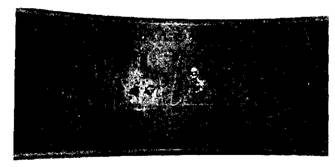20.5.
Connecting Rod and Main Bearing Failures
Causes and Classifications.
The reasons for bearing failures with their percentage are presented in Table 20.1. Connecting rod and main bearing failures can be classified as follows:
(i) Scoring or scarring (ii) Wiping or seizure (v) Erosion.
(Hi) Fatigue or lining breakout (iv) Corrosion
Scoring and Scarring.
Foreign materials such as metal particles, sand, and grit in the oil cause scoring and scarring of bearing. Poor finish of the crankshaft journals and crankpins also gives rise to this type of bearing failure. Figure 20.33 shows embedding of foreign particles in a bearing. c

Fig. 20.33. Foreign particles embedded in a bearing.
The engine oil if contaminated with major abrasives, causes severe scores (Fig. 20.34) on the bearings in the main bearing caps and the upper half of the connecting rods, because these bearings are subjected to the heaviest load condition. When the vehicle is operated in extremely
dusty conditions, the engine oil may be contaminated with fine sand, which results in fine abrasion of the bearings.

Fig. 20.34. Badly scored bearings.
When a piston failure occurs, aluminium flakes may indent or scar the bearing surfaces. If the crankshaft surfaces have not been adequately polished after the journals have been ground, then many fine cuts appear on the bearing surfaces. These fine score marks look like the grooves on a record.
Table 20.1. Causes of Connecting Rod and Main Bearing Failures.
| Dirt | 43.1% |
| Lack of lubrication | 14.9% |
| Misassembly | 13.6% |
| Misalignment | 10.0% |
| Overloading | 8.4% |
| Corrosion | 4.7% |
| Other | 5.3% |

Fig. 20.35. Bearing damage resulting from lack of lubrication.

Fig. 20.36. Bearing wears from a tapered journal.
Wiped and Burned.
Burning and wiping of bearings may take place due to a dry start and a lag in the oil supply. Insufficient bearing clearance also results in burned and wiped bearings. Severe overheating and inadequate lubrication cause lead smear and burned bearings. If the oil is diluted with gasoline, the bearings become burnished. The top half of the main bearing has an oil inlet hole for lubrication and the lower half of the bearing does not have an oil hole. If the bearing halves are interchanged, the oil supply to the bearing is shut off and the bearing is wiped and burned. Figure 20.35 illustrates bearing damage resulting from lack of lubrication. A lack of oil supply to the bearings
causes burned and extruded bearings linings.
If the bearings do not have the proper crush fit, they may move and turn with the crankshaft. If that happens the back of the bearings is burned when it turns in the connecting rod. If a rear main bearing seal is too tight it causes excessive heat build-up on the rear crankshaft journal so that the back half of the rear main bearing is burned. If the main bearing bores are misaligned, the centre main bearings and adjacent main bearings burn and
seize. Beaning-edge burning results if the main beaning housing or connecting rod
housing is tapered. Figure 20.36 shows a bearing wear ^rom a tapered journal.
Fatigue.
The crankshaft may become ridged in the journal area directly below the oil grooves in the upper halves of the main bearings. When such ridges occur, the crankshaft ridge causes a fatigue strip in the lower half of the main bearings. Figure 20.37 shows bearing fatigue failure.
If a connecting rod is misaligned, a V-shaped fatigue occurs at the edge of the connecting rod bearings. Fatigue at the adjacent parting faces on the bearings takes place if the bearing housing is out of round. Bearing edge fatigue is caused by an hourglass-shaped crankshaft-bearing journal.
The heaviest loading area in a bearing is a 120 degrees arc of the bearing due to the specified oil clearance space. The load is applied to the upper half of the connecting rod bearings and the lower half of the main bearings. If the bearing oil clearance exceeds specifications, the bearings are overstressed in a 30 to 45 degrees arc due to the excessive movement of the crankshaft or connecting rod.
Heavy engine load causes bearing fatigue in the upper connecting rod bearings, especially at low engine speeds. Also excessive engine speed causes bearing fatigue in the upper and lower connecting rod bearings.
Corrosion.
Corrosive acids may contaminate the engine oil because of excessive piston ring “blow-by”, internal antifreeze leaks or the use of high-sulpher fuels. Infrequent oil change intervals also cause oil contamination by corrosive acids. These corrosive acids convert the lead in the bearing material to a lead soap, which is subsequently washed out of the bearing so that the other bearing materials are exposed.
Erosion.
This is the uncommon type of bearing failure. When erosion occurs, there exists a gradual irregular deterioration of the bearing surface, which is caused by the hitting of surface by oil at high velocity and pressure.

Fig. 20.37. Bearing fatigue failure.
